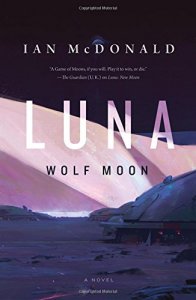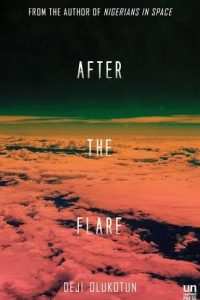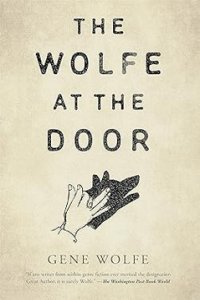Russell Letson reviews Ian McDonald
Luna: Wolf Moon, by Ian McDonald (Tor 978-0-7653-7553-7, $27.99, 400pp, hardcover) March 2017
 Twenty-seven years ago this month [May], Charles Brown took me on as a reviewer – specifically, he said, to cover the hard-SF end of the field. Of course, Locus neither draws nor enforces sharp boundaries among and between reviewers’ beats, so I have spent the decades following my nose all over the genre(s) rather than pursuing the grail of One True SF. Nevertheless, to paraphrase Judith Merril, that pesky question of ‘‘what do you mean, hard? SF?’’ lingers, and the titles at hand this month have me poking at that wasp-nest yet again.
Twenty-seven years ago this month [May], Charles Brown took me on as a reviewer – specifically, he said, to cover the hard-SF end of the field. Of course, Locus neither draws nor enforces sharp boundaries among and between reviewers’ beats, so I have spent the decades following my nose all over the genre(s) rather than pursuing the grail of One True SF. Nevertheless, to paraphrase Judith Merril, that pesky question of ‘‘what do you mean, hard? SF?’’ lingers, and the titles at hand this month have me poking at that wasp-nest yet again.
And I do mean wasp-nest. Theological debates have nothing on arguments over the relative hardness of various sciences or how many physicists it takes to screw up a starship design. Most of these arguments generate more heat than light, but if pushed up against the alley wall, I might finally admit that one of the things that makes for ‘‘hard’’ SF is a sense of constraints – they might originate in physics and orbital mechanics, but they can also extend to a recognition that social, political, economic, and even psychological systems are not infinitely elastic, that they all impose limits on our actions. (This applies to fantasy as well – dreams of unlimited magical powers are not for grownups.) This month’s books deploy speculative technologies that range from the almost-within-our-grasp to the near-magical, but they both qualify as hard SF in their acceptance of the role of limits and their acknowledgment of what happens when we smack into them nose-first.
Ian McDonald’s Luna: Wolf Moon (the second-act volume in the sequence that opened last year with Luna: New Moon) is instantly recognizably as hard SF: it’s set only a century from now, in a future developed from current conditions and built on technologies that we can imagine evolving from today’s cutting-edge efforts in AI, medicine, and engineering. It is a world of wonders: cities on (under, actually) the Moon, giant automated industrial projects, miraculous medical facilities, exotic social systems and psychological adaptations, and plentiful luxuries (for the rich and powerful, anyway). But wonders are not free, and the physical environment and human nature refuse to stand aside to permit unfettered happily-ever-afters. Quite the opposite, in fact.
There are other genres layered onto this familiarly science-fictional setup, categories as powerful as any speculative world-building. The jacket blurbs fasten on the dynastic rivalries of Game of Thrones (or Dallas or the Godfather movies), to which I would add (and have already done, in reviewing the first book) Jacobean drama: the books’ generation-spanning blood feuds, revenges, betrayals, intrigues, and its oligarchs and innocents and malcontents, would do a revenge tragedy proud.
And there’s plenty to avenge. Luna: New Moon ended with the downfall of one of the moon’s Five Dragon clans, the Cortas, at the hands of rival Mackenzie Metals, in a strike meant to wipe out the family and appropriate their helium-mining business. Wolf Moon begins with a terrible Corta retribution and then follows a handful of Corta survivors and several Mackenzies as powers rebalance and further vengeance is planned and set in motion. Lucas Corta escapes to Earth, where he seeks allies to support a return. His son, the teenage playboy Lucasihno, and his nine-year-old niece Luna have been spared the slaughter but are powerless and vulnerable. Matrimonial lawyer Ariel is paralyzed and paupered and sidelined. Her Earthborn assistant and bodyguard, Marina Calzaghe, remains loyal even as she faces her Moonday, when she must decide whether to leave the moon or remain forever physiologically bound to it.
Plenty of other cast members get their own viewpoint sections, allowing us to follow the plotting and maneuvers of the factions within as well as between the families and other power blocs. Of particular interest are Wagner Corta, a ‘‘wolf,’’ and Alexia Corta, head of a branch of the family left behind on Earth two generations earlier. Both are fierce personalities even in a drama filled with scarily intense characters. Wagner’s werewolf identity is rooted in bipolar disorder, but ‘‘push[ed] in another direction altogether’’ by medications and ‘‘a social frame… a culture that accepts and supports it.’’ His divided self shifts between light and dark phases as the Earth waxes and wanes in the lunar sky, and he feels closer to his pack than to his family, at least until he takes responsibility for his 13-year-old nephew Robson, who is, thanks to a dynastic marriage, both a Corta and a Mackenzie. Alexia, whose drive and enterprise (and don’t-mess-with-me-and-mine attitude) have made a secure place for her in the hardscrabble parts of Rio de Janeiro, seizes the opportunity when Lucas comes down to build alliances against the lunar powers and makes herself his Iron Fist.
Not that the rest of the dramatis personae are pussycats, and various of them are responsible for betrayal, murder, kidnapping, blackmail, massacre, sabotage, putsch, and, finally, dire warfare. They are monsters – and also marvels of loyalty, courage, and resilience, as in Wagner’s devotion to Robson or in Lucasinho and Luna’s heroic trek through all the hazards the moon and warfare can offer. As Lucas observed back in New Moon, people are ‘‘your worst enemy and your best hope.’’
Wolf Moon is also filled with the poetry of fact – of precise observation, of understanding processes, of concreteness and accuracy of depiction. The main narrative opens with Robson Corta surviving a three-kilometer plummet from the top level of a lunar city in the course of a traceur run (the moon’s version of parkour). ‘‘There are,’’ he knows, ‘‘rules of falling,’’ and a four-page sequence enumerates them and details Robson’s execution of the appropriate measures
This passage is echoed during Lucas Corta’s trip to the Earth, where the quantitative and the sensory combine in a description of the tether-transfer system that flings an automated passenger capsule from a constantly-circulating craft to a catcher-shuttle and down to the planet. Lucas knows ‘‘how it all worked. It was controlled falling.’’ He feels ‘‘bangs [and] lurches’’ and vibrations and shaking and ‘‘savage’’ bodydistorting decelerations, and he understands that the process is governed by numbers: the number of gravities of deceleration to be endured, orbital altitude, the duration of re-entry, the temperature reached by the capsule’s hull, the speed at touchdown, and finally ‘‘Zero. The number of crew who could take the controls if anything went wrong.’’
Similar passages remind the characters (and us) of the envelope within which lunar social and economic life must fit, the unforgiving nature of the lunar environment and the fragility of what humans have built there: the constant threats of vacuum and radiation and dust, the need for airlock seals and escape pods and safety protocols.
Of course, it’s not all backstabbing and blowouts. The lunar social world offers an array of experiments in political, economic, personal, and interpersonal arrangements. Practically (or even impractically) every imaginable variety of sexual identity and expression is available, and domestic/amatory relationships are matters of free-association and contract. These personal choices signal the nature of this polity, so it is probably appropriate that marriage lawyer Ariel provides the clearest articulation of the libertarian-contractual vision of lunar political thinking:
It’s individualistic and it’s atomising and it’s harsh but it is understood. And the limits are clear…. There are individuals, there are families, there are corporations…. We are unsophisticated grudge-bearing barbarians. I rather like it.
Even here there are limits, though, imposed by the human rather than the physical environment. It’s not just the usual stew of competitiveness and greed, of family loyalty and corresponding rivalries and blood-feud, but, from far down in the psyches of the moon’s inhabitants, where run deep currents of the supra-rational, the myth-soaked, and the near-mystical: religions and quasi-religious associations and the nearly-superstitious sense of more-than-human forces at work (the Luna that kills).
Whether it is in descriptions of moonscapes or industrial processes or assassinations or robotic warfare or family reunions (with or without assassinations), McDonald’s language can and does rise to the occasion, as it must if it is to drive a story so ambitious in its portrayal of humankind at the limits of its power to create and destroy.
–Russell Letson



